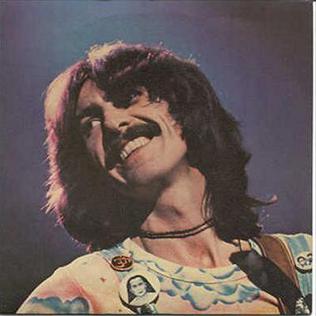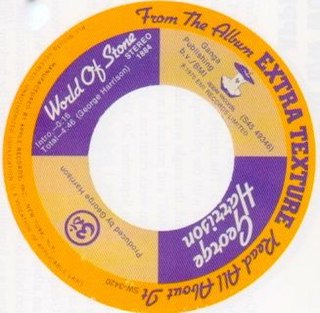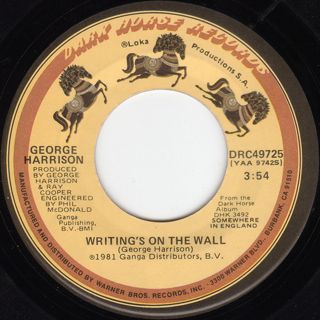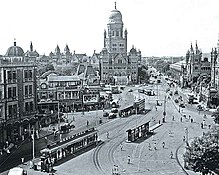
Dark Horse Records is a record label founded by former Beatle George Harrison in 1974. The label's formation coincided with the winding down of the Beatles' Apple Records and allowed Harrison to continue supporting other artists' projects while maintaining his solo career. The initial signings were Indian musician Ravi Shankar and Splinter, the latter of whom provided the label with its only significant commercial success until Harrison himself signed with Dark Horse in 1976. The label was distributed internationally by A&M Records for the first two years of its operation. Following a highly publicised split with A&M, Harrison and Dark Horse formed a long-term partnership with Warner Bros. Records that lasted until the expiration of his contract in 1994.

Thirty Three & 1⁄3 is the seventh studio album by English musician George Harrison, released in November 1976. It was Harrison's first album release on his Dark Horse record label, the worldwide distribution for which changed from A&M Records to Warner Bros. as a result of his late delivery of the album's master tapes. Among other misfortunes affecting its creation, Harrison suffered hepatitis midway through recording, and the copyright infringement suit regarding his 1970–71 hit song "My Sweet Lord" was decided in favour of the plaintiff, Bright Tunes Music. The album contains the US top 30 singles "This Song" – Harrison's satire on that lawsuit and the notion of plagiarism in pop music – and "Crackerbox Palace". Despite the problems associated with the album, many music critics recognised Thirty Three & 1⁄3 as a return to form for Harrison after his poorly received work during 1974–75, and considered it his strongest collection of songs since 1970's acclaimed All Things Must Pass.

Dark Horse is the fifth studio album by English rock musician George Harrison. It was released on Apple Records in December 1974 as the follow-up to Living in the Material World. Although keenly anticipated on release, Dark Horse is associated with the controversial North American tour that Harrison staged with Indian classical musician Ravi Shankar in November and December that year. This was the first US tour by a member of the Beatles since 1966, and the public's nostalgia for the band, together with Harrison contracting laryngitis during rehearsals and choosing to feature Shankar so heavily in the programme, resulted in scathing concert reviews from some influential music critics.

"Dark Horse" is a song by English rock musician George Harrison and the title track to his 1974 solo album on Apple Records. The song was the album's lead single in North America, becoming a top-20 hit in the United States, but it was Harrison's first single not to chart in Britain when issued there in February 1975. The term "dark horse" had long been applied to Harrison due to his unexpected emergence as the most accomplished solo artist of the four former Beatles following the band's break-up in 1970. In the song, however, he said he used the phrase in reference to gossip about someone who carries out clandestine sexual relationships. Commentators interpret the lyrics as a rebuttal to several possible detractors: Harrison's first wife, Pattie Boyd; reviewers who criticised the spiritual content of his 1973 album Living in the Material World; and his former bandmates John Lennon and Paul McCartney. Harrison named his Dark Horse record label after the song, and his 1974 North American tour with Ravi Shankar came to be known as the Dark Horse Tour.

"Ding Dong, Ding Dong" is a song by English rock musician George Harrison, written as a New Year's Eve singalong and released in December 1974 on his album Dark Horse. It was the album's lead single in Britain and some other European countries, and the second single, after "Dark Horse", in North America. A large-scale production, the song incorporates aspects of Phil Spector's Wall of Sound technique, particularly his Christmas recordings from 1963. In addition, some Harrison biographers view "Ding Dong" as an attempt to emulate the success of two glam rock anthems from the 1973–74 holiday season: "Merry Xmas Everybody" by Slade, and Wizzard's "I Wish It Could Be Christmas Everyday". The song became only a minor hit in Britain and the United States, although it was a top-twenty hit elsewhere in the world.

"You" is a song by English musician George Harrison, released as the opening track of his 1975 album Extra Texture . It was also the album's lead single, becoming a top 20 hit in America and reaching number 9 in Canada. A 45-second instrumental portion of the song, titled "A Bit More of You", appears on Extra Texture also, opening side two of the original LP format. Harrison wrote "You" in 1970 as a song for Ronnie Spector, formerly of the Ronettes, and wife of Harrison's All Things Must Pass co-producer Phil Spector. The composition reflects Harrison's admiration for 1960s American soul/R&B, particularly Motown.
"Far East Man" is a song written by English rock musicians George Harrison and Ronnie Wood, each of whom released a recording of the song in 1974. Wood's version appeared on I've Got My Own Album to Do, his debut solo album, and Harrison's on Dark Horse. Their only official songwriting collaboration, "Far East Man" is an affirmation of friendship in the face of life's obstacles and musically reflects the two guitarists' adoption of the soul genre. Written mostly by Harrison, the composition has been interpreted as a restatement of the humanitarian message expressed in his 1971 single "Bangla Desh", and a tribute to Indian musician Ravi Shankar.
"Sue Me, Sue You Blues" is a song written by English musician George Harrison, released on his 1973 album Living in the Material World. Harrison initially let American guitarist Jesse Ed Davis record it for the latter's Ululu album (1972), in gratitude to Davis for his participation in the Concert for Bangladesh. When writing the song, Harrison drew inspiration from the legal issues surrounding the Beatles during the early months of 1971, particularly the lawsuit that Paul McCartney initiated in an effort to dissolve the band's business partnership, Apple Corps.

"World of Stone" is a song by English rock musician George Harrison, released in 1975 on Extra Texture , his final album for Apple Records. It was also issued as the B-side of the album's lead single, "You". Harrison wrote the song in 1973 but recorded it two years later, following the unfavourable critical reception afforded his 1974 North American tour with Ravi Shankar and the Dark Horse album. Due to its context on release, commentators view "World of Stone" as a plea from Harrison for tolerance from these detractors. According to some of his biographers, the lyrics reflect Harrison's doubts regarding his devotion to a spiritual path – an apparent crisis of faith that followed his often-unwelcome spiritual pronouncements during the tour, and which permeated his work throughout 1975.

"Hari's on Tour (Express)" is an instrumental by English musician George Harrison, released as the opening track of his 1974 album Dark Horse. It was also the B-side of the album's second single – which was "Ding Dong, Ding Dong" in North America and most other territories, and "Dark Horse" in Britain and some European countries. Among Harrison's post-Beatles solo releases, the track is the first of only two genuine instrumentals he released from 1970 onwards – the other being the Grammy Award-winning "Marwa Blues", from his 2002 album Brainwashed.

"Māya Love" is a song by English musician George Harrison, released on his 1974 album Dark Horse. The song originated as a slide guitar tune, to which Harrison later added lyrics relating to the illusory nature of love – maya being a Sanskrit term for "illusion", or "that which is not". Harrison's biographers consider the lyrical theme to be reflective of his failed marriage to Pattie Boyd, who left him for his friend Eric Clapton shortly before the words were written. Harrison recorded the song at his home, Friar Park, on the eve of his North American tour with Ravi Shankar, which took place in November and December 1974. The recording features Harrison's slide guitar extensively and contributions from four musicians who formed the nucleus of his tour band: Billy Preston, Tom Scott, Willie Weeks and Andy Newmark. Reviewers note the track as an example of its parent album's more diverse musical genres, namely funk and rhythm and blues, compared with the more traditional rock orientation of Harrison's earlier solo work.
"It Is 'He' " is a song by English musician George Harrison, released as the final track of his 1974 album Dark Horse. Harrison was inspired to write the song while in the Hindu holy city of Vrindavan, in northern India, with his friend Ravi Shankar. The composition originated on a day that Harrison describes in his autobiography as "my most fantastic experience", during which his party and their ascetic guide toured the city's temples. The song's choruses were adapted from the Sanskrit chant they sang before visiting Seva Kunj, a park dedicated to Krishna's childhood. The same pilgrimage to India led to Harrison staging Shankar's Music Festival from India in September 1974 and undertaking a joint North American tour with Shankar at the end of that year.
"Can't Stop Thinking About You" is a song by English musician George Harrison, released in 1975 on his final album for Apple Records, Extra Texture . A love song in the style of a soul/R&B ballad, it was written by Harrison in December 1973, towards the end of his marriage to Pattie Boyd and while he was having an affair with Maureen Starkey, the wife of his former Beatles bandmate Ringo Starr. Having first considered the song for his 1974 release Dark Horse, Harrison recorded "Can't Stop Thinking About You" in Los Angeles in May 1975 for his so-called "soul album", Extra Texture. Some authors view its inclusion on the latter release as an obvious attempt by Harrison to commercialise the album, in response to the harsh critical reception afforded Dark Horse and his 1974 North American tour.
"His Name Is Legs (Ladies and Gentlemen)" is a song by English rock musician George Harrison, released in 1975 as the closing track of his album Extra Texture (Read All About It). The song is a tribute to "Legs" Larry Smith, the drummer with the 1960s satirical-comedy group the Bonzo Dog Doo-Dah Band and one of many comedians with whom Harrison began associating during the 1970s. Smith appears on the recording, delivering a spoken monologue, while Harrison's lyrics similarly reflect the comedian's penchant for zany wordplay. The song serves as a precursor to Harrison's work with Monty Python members Eric Idle and Michael Palin, including his production of the troupe's 1975 single "The Lumberjack Song" and films such as Life of Brian (1979) that he produced under the aegis of his company HandMade Films.

"Soft Touch" is a song by English rock musician George Harrison from his 1979 album George Harrison. It was also issued as the B-side of the album's lead single, "Blow Away", in Britain and some other countries, while in markets such as North America, it was the B-side of the second single, "Love Comes to Everyone". Harrison wrote the song while in the Virgin Islands with his future wife, Olivia Arias, shortly before recording his 1976 album Thirty Three & ⅓. The song is a love song in which Harrison also conveys his wonder at the idyllic island setting.

"Writing's on the Wall" is a song by English musician George Harrison from his 1981 album Somewhere in England. It was also the B-side of the album's lead single, "All Those Years Ago", which Harrison wrote as a tribute to his former Beatles bandmate John Lennon. In his lyrics, Harrison sings of the transient nature of life and the importance of recognising a spiritual purpose. Although the song was written long before Lennon's murder in New York in December 1980, the lyrics' reference to how easily friends can be shot down and killed led listeners to interpret it as a further comment on Lennon's death.
"So Sad" is a song by English rock musician George Harrison that was released on his 1974 album Dark Horse. Harrison originally recorded the song for his previous album, Living in the Material World, before giving it to Alvin Lee, the guitarist and singer with Ten Years After. Lee recorded it – as "So Sad " – with gospel singer Mylon LeFevre for their 1973 album On the Road to Freedom. The latter recording includes contributions from Harrison and marked the first of several collaborations between him and Lee.

"I Don't Care Anymore" is a song by English musician George Harrison, released as the B-side of the lead single from his 1974 album Dark Horse. The A-side was "Dark Horse" in the majority of countries internationally and "Ding Dong, Ding Dong" elsewhere, including the United Kingdom. It is one of Harrison's relatively rare compositions in the country music genre and, equally unusual among his 1970s releases, the recording is a solo performance.

George Harrison and Ravi Shankar's 1974 North American tour was a 45-show concert tour of the United States and Canada, undertaken by English musician George Harrison and Indian sitarist Ravi Shankar in November and December 1974. It is often referred to as the Dark Horse Tour, since the concerts served as a launch for Harrison's record label Dark Horse Records, to which Shankar was one of the inaugural signings, and Harrison's concurrent single was the song "Dark Horse". The release of his delayed album, also titled Dark Horse, followed towards the end of the tour. The shows featured guest spots by Harrison's band members Billy Preston and Tom Scott.















